Kinetic Potentiometry as a Method for Studying the Interactions of Antioxidants with Peroxyl Radicals
Abstract
1. Introduction
2. Materials and Methods
2.1. Equipment and Reagents
2.2. Objects of Research
2.3. Research Methods
2.3.1. Determination of the Residual Concentration of Antioxidants
2.3.2. Potentiometric Method for Determining Antiradical Capacity Using a Radical Generating System
3. Results
- Initiation:I → 2 RO2•Wi = 2ki·[I]
- Recombination/disproportionation of the RO2•:RO2• + RO2• → products (k2)
- Interaction with AO:where ki is the rate constant of peroxyl radicals generation of (1 × 106 s−1); k2 is the rate constant of peroxyl radicals recombination (2.6 × 104 s−1); kinh is the rate constant of the reaction of an antioxidant with peroxyl radicals.RO2• + AORed → RO2− + AOOx (kinh)
Determination of the Reaction Rate Constant of an Antioxidant with Peroxyl Radicals
4. Conclusions
Author Contributions
Funding
Institutional Review Board Statement
Informed Consent Statement
Data Availability Statement
Conflicts of Interest
References
- Halliwell:, B.; Gutteridge, J.M.C. Free Radicals in Biology and Medicine, 5th ed.; Oxford University Press: Oxford, UK, 2015. [Google Scholar]
- Li, S.; Zheng, L.; Zhang, J.; Liu, X.; Wu, Z. Inhibition of ferroptosis by up-regulating Nrf2 delayed the progression of diabetic nephropathy. Free Radic. Biol. Med. 2021, 162, 435–449. [Google Scholar] [CrossRef] [PubMed]
- Zhao, S.; Chen, C.; Li, Z.; Yuan, Z.; Lu, C. Hydroxyl radical induced chemiluminescence of hyperbranched polyethyleneimine protected silver nanoclusters and its application in tea polyphenols detection. Anal. Methods 2017, 9, 3114–3120. [Google Scholar] [CrossRef]
- Rančić, A.; Babić, N.; Orio, M.; Peyrot, F. Structural Features Governing the Metabolic Stability of Tetraethyl-Substituted Nitroxides in Rat Liver Microsomes. Antioxidants 2023, 12, 402. [Google Scholar] [CrossRef] [PubMed]
- Chatgilialoglu, C.; Ferreri, C.; Guerra, M.; Samadi, A.; Bowry, V.W. The Reaction of Thiyl Radical with Methyl Linoleate: Completing the Picture. J. Am. Chem. Soc. 2017, 139, 4704–4714. [Google Scholar] [CrossRef]
- Pratt, D.A.; Tallman, K.A.; Porter, N.A. Free Radical Oxidation of Polyunsaturated Lipids: New Mechanistic Insights and the Development of Peroxyl Radical Clocks. Acc. Chem. Res. 2011, 44, 458–467. [Google Scholar] [CrossRef]
- López-Alarcón, C.; Fuentes-Lemus, E.; Figueroa, J.D.; Dorta, E.; Schöneich, C.; Davies, M.J. Azocompounds as generators of defined radical species: Contributions and challenges for free radical research. Free Rad. Biol. Med. 2020, 160, 78–91. [Google Scholar] [CrossRef]
- Moreira Gomes, M.D.; Carvalho, G.M.C.; Casquilho, N.V.; Araújo, A.C.P.; Valença, S.S.; Leal-Cardoso, J.H.; Zin, W.A. 2,2′-Azobis (2-Amidinopropane) Dihydrochloride Is a Useful Tool to Impair Lung Function in Rats. Front. Physiol. 2016, 7, 475. [Google Scholar] [CrossRef] [PubMed]
- Hadjipavlou-Litina, D.; Głowacka, I.E.; Marco-Contelles, J.; Piotrowska, D.G. Synthesis and Antioxidant Properties of Novel 1,2,3-Triazole-Containing Nitrones. Antioxidants 2023, 12, 36. [Google Scholar] [CrossRef]
- Zargoosh, K.; Tabibi, A.; Kianfar, A.H.; Dostani, M.; Qandalee, M.; Naderi, G.A. Quenching-free chemiluminescence method for ranking the antioxidants and inhibition of AAPH-induced membrane peroxidation of red blood cells using new aminophenol derivative. J. Lumin. 2017, 192, 582–589. [Google Scholar] [CrossRef]
- Dresch, M.T.K.; Rossato, S.B.; Kappel, V.D.; Biegelmeyer, R.; Hoff, M.L.M.; Mayorga, P.; Zuanazzi, J.A.S.; Henriques, A.T.; Moreira, J.C.F. Optimization and validation of an alternative method to evaluate total reactive antioxidant potential. Anal. Biochem. 2009, 385, 107–114. [Google Scholar] [CrossRef]
- Apak, R.; Ozyurek, M.; Guklu, K.; Capanoglu, E. Antioxidant Activity/Capacity Measurement. 2. Hydrogen Atom Transfer (HAT)-Based, Mixed-Mode (Electron Transfer (ET)/HAT), and Lipid Peroxidation Assays. J. Agric. Food Chem. 2016, 64, 1028–1045. [Google Scholar] [CrossRef] [PubMed]
- Rusina, I.F.; Karpukhin, O.N.; Kasaikina, O.T. Chemiluminescent methods for studying inhibited oxidation. Russ. J. Phys. Chem. 2013, 7, 463–477. [Google Scholar] [CrossRef]
- Krasovska, A.; Rosiak, D.; Czkapiak, K.; Lukaszewicz, M. Chemiluminescence detection of peroxyl radicals and comparison of antioxydant activity of phenolic compounds. Curr. Top. Biophys. 2000, 24, 89–95. [Google Scholar]
- Ivanova, A.V.; Gerasimova, E.L.; Gazizullina, E.R. New antiradical capacity assay with the use potentiometric method. Anal. Chim. Acta 2019, 1046, 69–76. [Google Scholar] [CrossRef]
- Ivanova, A.V.; Gerasimova, E.L.; Gazizullina, E.R. An integrated approach to the investigation of antioxidant properties by Potentiometry. Anal. Chim. Acta 2020, 1111, 83–91. [Google Scholar] [CrossRef]
- Apak, R.; Gorinstein, S.; Böhm, V.; Schaich, K.M.; Özyürek, M.; Güçlü, K. Methods of measurement and evaluation of natural antioxidant capacity/activity (IUPAC Technical Report). Pure Appl. Chem. 2013, 85, 957–998. [Google Scholar] [CrossRef]
- Shargel, L.; Wu-Pong, S.; Yu, A.B.C. Applied Biopharmaceutics & Pharmacokinetics, 6th ed.; McGraw-Hill Education: New York, NY, USA, 2012; p. 929. [Google Scholar]
- Agarwal, A.; Durairajanayagam, D.; Virk, G.; Du Plessis, S.S. Strategies to Ameliorate Oxidative Stress during Assisted Reproduction; Springer International Publishing: Berlin/Heidelberg, Germany, 2014. [Google Scholar]
- Ilyasov, I.; Beloborodov, V.; Antonov, D.; Dubrovskaya, A.; Terekhov, R.; Zhevlakova, A.; Saydasheva, A.; Evteev, V.; Selivanova, I. Flavonoids with Glutathione Antioxidant Synergy: Influence of Free Radicals Inflow. Antioxidants 2020, 9, 695. [Google Scholar] [CrossRef]
- Ivanova, A.; Gerasimova, E.; Gazizullina, E.; Borisova, M.; Drokin, R.; Gorbunov, E.; Ulomskiy, E.; Rusinov, V. The antioxidant screening of potential materials for drugs based on 6-nitro-1,2,4-triazoloazines containing natural polyphenol fragments. Anal. Bioanal. Chem. 2020, 412, 5147–5155. [Google Scholar] [CrossRef]
- Gerasimova, E.L.; Gazizullina, E.G.; Igdisanova, D.I.; Sidorova, L.P.; Tseitler, T.A.; Emelianov, V.V.; Chupakhin, O.N.; Ivanova, A.V. Antioxidant properties of 2,5-substituted 6H-1,3,4-thiadiazines promising for experimental therapy of diabetes mellitus. Russ. Chem. Bull. 2022, 71, 2730–2739. [Google Scholar] [CrossRef]
- Ivanova, A.V.; Gerasimova, E.L.; Brainina, K.Z. Potentiometric Study of Antioxidant Activity: Development and Prospects. Crit. Rev. Anal. Chem. 2015, 45, 311–322. [Google Scholar] [CrossRef]
- Glassman, P.M.; Muzykantov, V.R. Pharmacokinetic and Pharmacodynamic Properties of Drug Delivery Systems. J. Pharmacol. Exp. Ther. 2019, 370, 570–580. [Google Scholar] [CrossRef] [PubMed]
- Fershal, M.; Yankovych, H.; Studenyak, Y.; Bazel, Y.; Koplík, R.; Revenco, D. Combination of sequential injection analysis with an integrated [BF4]-potentiometric sensor for the kinetic determination of boron. Sens. Actuators B Chem. 2019, 297, 126778. [Google Scholar] [CrossRef]
- Atta-Politou, J.; Koupparis, M.; Macheras, P. Development of a potentiometric kinetic method for drug adsorption studies: The chlorpromazine-charcoal model case. Eur. J. Pharm. Sci. 1996, 4, 223–230. [Google Scholar] [CrossRef]
- Sueishi, Y.; Hori, M.; Ishikawa, M.; Matsu-ura, K.; Kamogawa, E.; Honda, Y.; Kita, M.; Ohara, K. Scavenging rate constants of hydrophilic antioxidants against multiple reactive oxygen species. J. Clin. Biochem. Nutr. 2014, 54, 67–74. [Google Scholar] [CrossRef]
- Zinatullina, K.M.; Kasaikina, O.T.; Kuzmin, V.A.; Khrameeva, N.P.; Shapiro, B.I. Reaction of polymethine dyes with hydroperoxides and free radicals. Russ. Chem. Bull. 2016, 65, 2825–2831. [Google Scholar] [CrossRef]
- Belyakov, V.A.; Roginsky, V.A.; Bors, W. Rate constants for the reaction of peroxyl free radical with flavonoids and related compounds as determined by the kinetic chemiluminescence method. Chem. Soc. Perkin Trans. 1995, 2, 2319–2326. [Google Scholar] [CrossRef]
- Vladimirov, Y.A.; Proskurnina, E.V.; Izmajlov, D.Y. Kinetic chemiluminescence as a method for study of free radical reactions. Biophysics 2011, 56, 1055–1062. [Google Scholar] [CrossRef]
- Usol’tseva, S.V.; Andronnikova, G.P.; Mokrushin, V.S. 1,3,4-Thiadiazines: Methods of synthesis and reactivity (review). Chem. Heterocycl. Compd. 1991, 27, 343–354. [Google Scholar] [CrossRef]
- Cabello, M.C.; Bartoloni, F.H.; Bastos, E.L.; Baader, W.J. The Molecular Basis of Organic Chemiluminescence. Biosensors 2023, 13, 452. [Google Scholar] [CrossRef]
- Radicć, N.; Kukoc-Modun, L. Kinetic Methods of Analysis with Potentiometric and Spectrophotometric Detectors—Our Laboratory Experiences. In Analytical Chemistry, 1st ed.; Krull, I.S.S., Ed.; IntechOpen: London, UK, 2012. [Google Scholar]


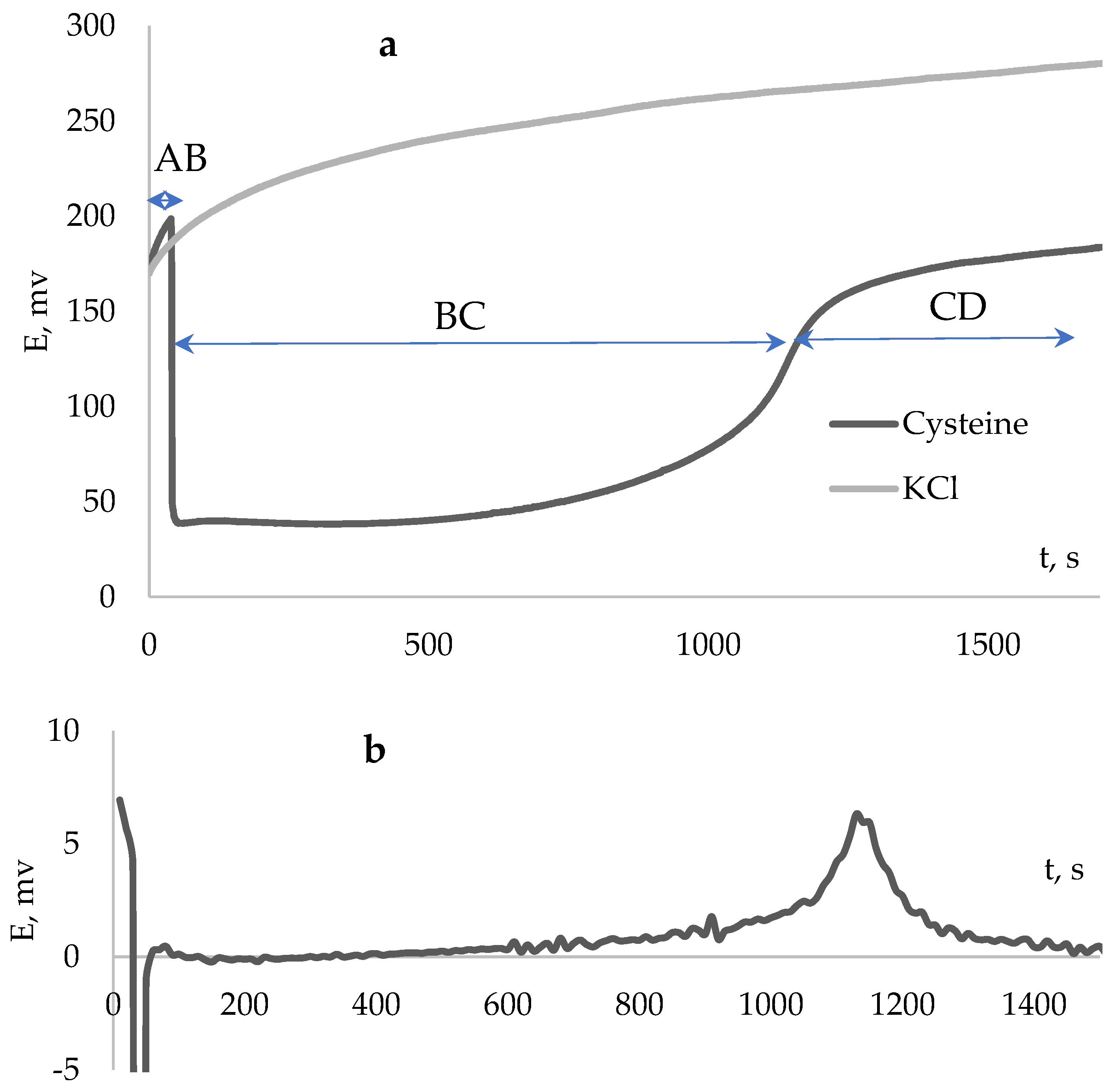
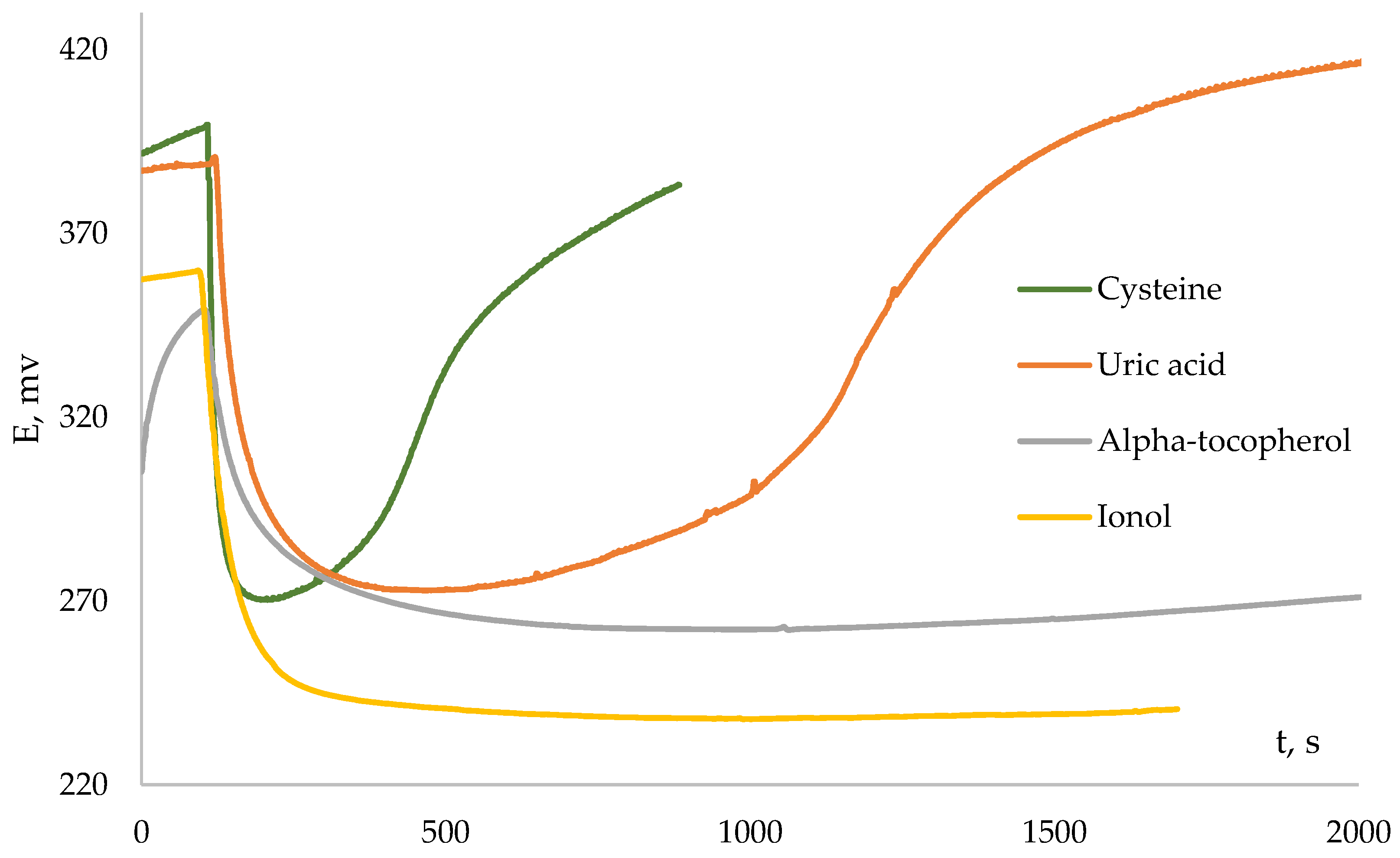
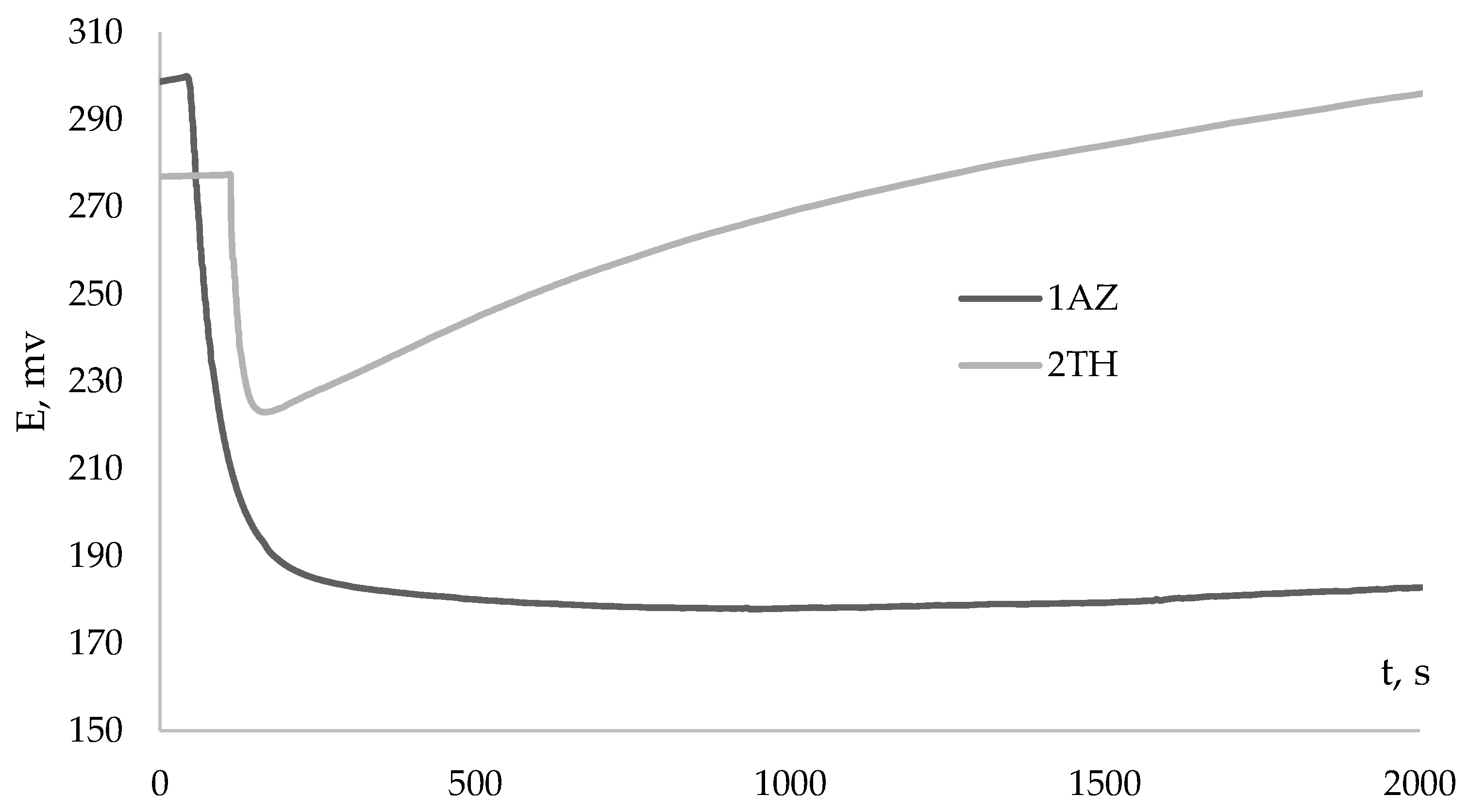

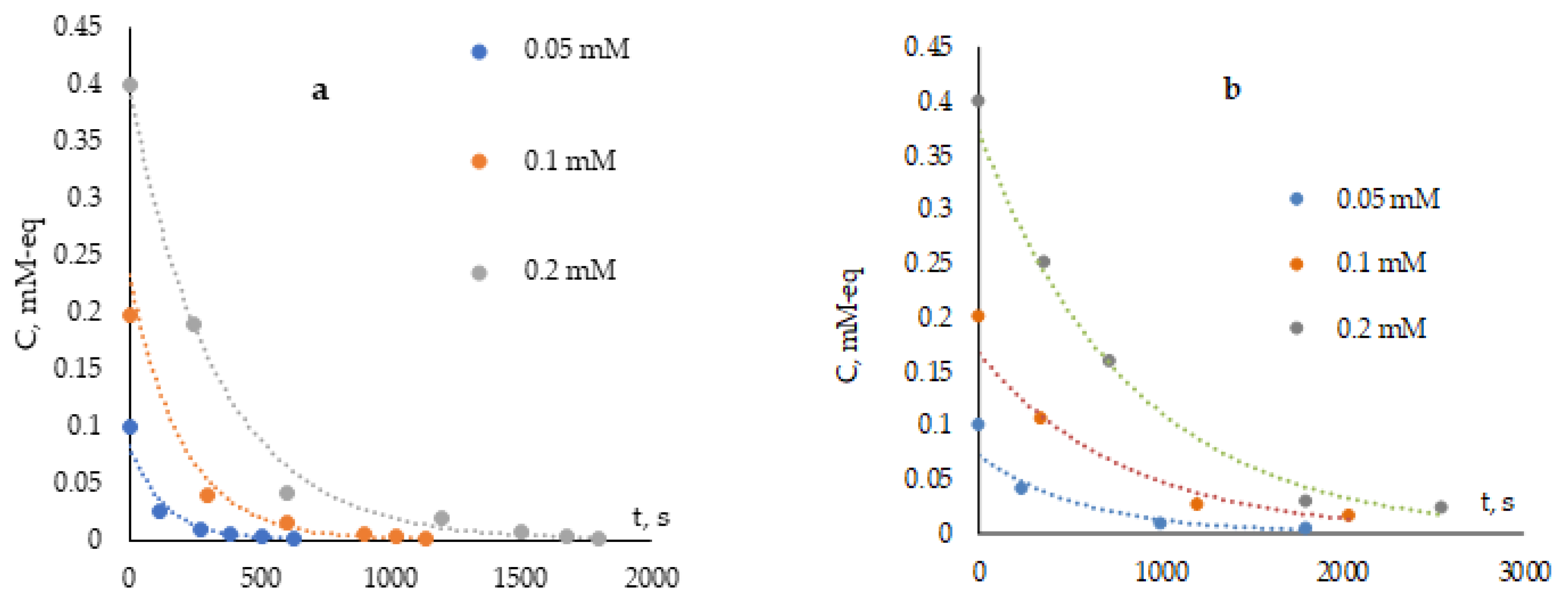


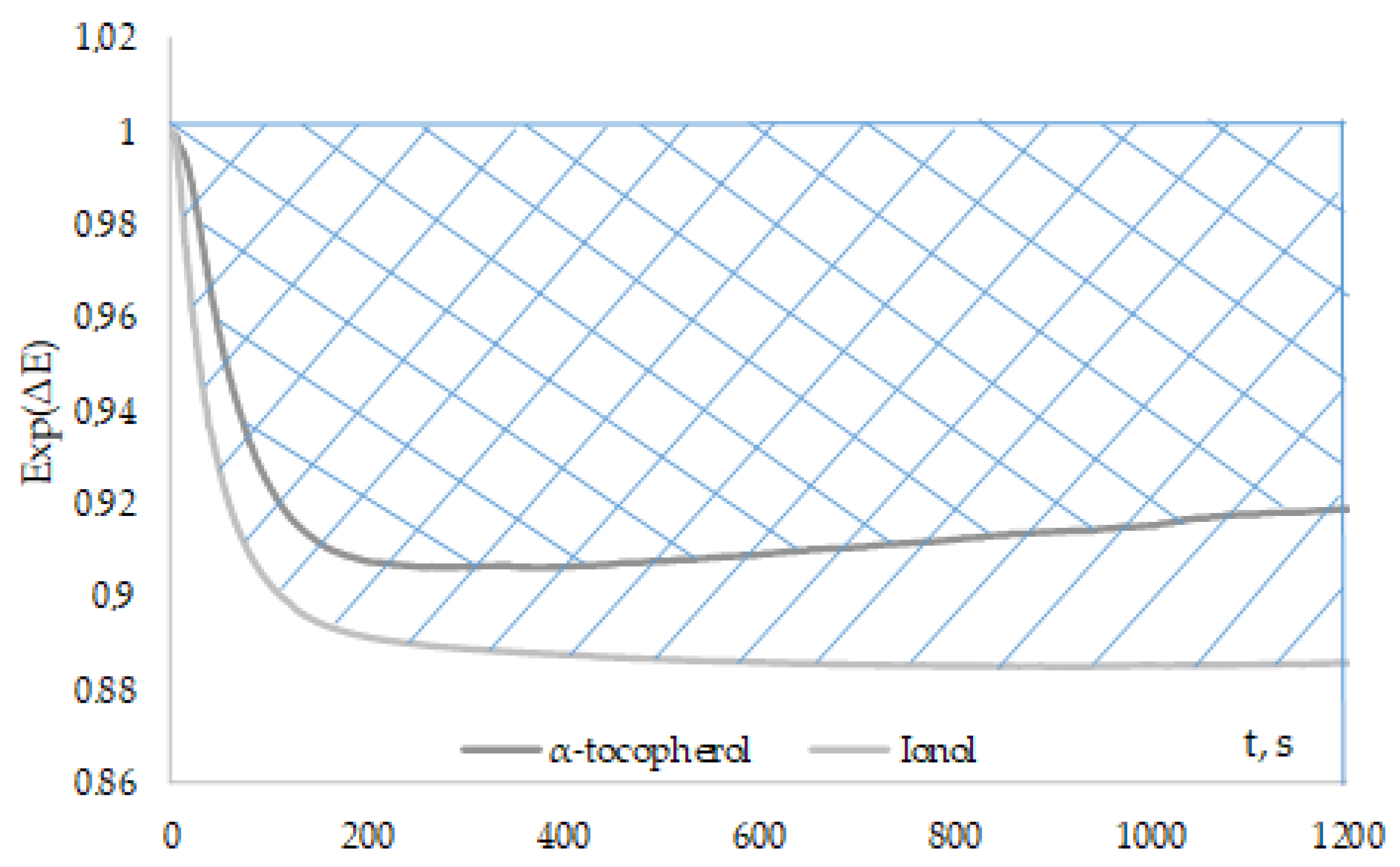

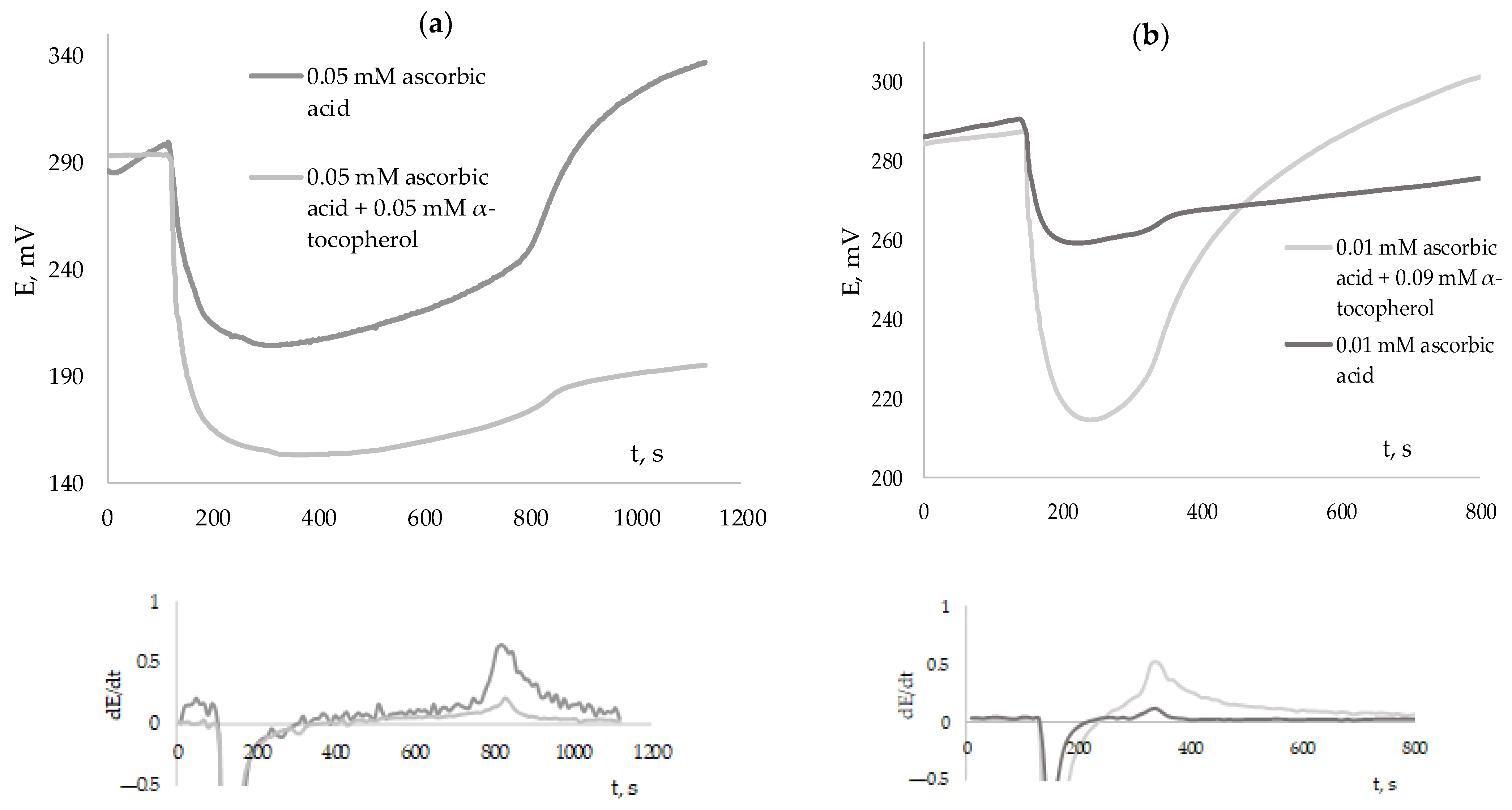
| Antioxidant | kinh, 103 s−1 |
|---|---|
| Ascorbic acid | 3.95 ± 0.12 |
| Glutathione | 9.25 ± 0.14 |
| Uric acid | 3.30 ± 0.10 |
| L-cysteine | 5.75 ± 0.09 |
| Catechol | 1.20 ± 0.02 |
| Gallic acid | 2.50 ± 0.03 |
| Chlorogenic acid | 1.05 ± 0.05 |
| Caffeic acid | 2.60 ± 0.08 |
| α-tocopherol | 0.75 ± 0.02 |
| 2.6-ditertbutylphenol | 0.40 ± 0.02 |
| Ionol | 0.70 ± 0.03 |
| 1AZ | 0.75 ± 0.01 |
| 2AZ | 0.85 ± 0.02 |
| Antioxidant | S*ARC, s | Sr | S**ARC, s | Sr |
|---|---|---|---|---|
| Ascorbic acid | 117 ± 9 | 0.10 | 98 ± 8 | 0.09 |
| Uric acid | 194 ± 18 | 0.11 | 162 ± 16 | 0.10 |
| Glutathione | 40 ± 4 | 0.12 | 36 ± 4 | 0.13 |
| Catechol | 287 ± 26 | 0.09 | 267 ± 28 | 0.11 |
| Gallic acid | 232 ± 21 | 0.10 | 202 ± 11 | 0.06 |
| Chlorogenic acid | 218 ± 22 | 0.12 | 201 ± 20 | 0.11 |
| Caffeic acid | 340 ± 33 | 0.11 | 333 ± 23 | 0.08 |
| Antioxidant | S**ARC, c | Sr |
|---|---|---|
| α-tocopherol | 101 ± 9 | 0.10 |
| 2.6-ditrebutylphenol | 189 ± 16 | 0.12 |
| Ionol | 130 ± 12 | 0.09 |
| 1AZ | 30 ± 3 | 0.11 |
| 2AZ | 36 ± 3 | 0.12 |
| Antioxidant | CAO, mM | S**ARC, s | Sr |
|---|---|---|---|
| α-tocopherol | 0.1 | 101 ± 9 | 0.10 |
| 0.3 | 258 ± 24 | 0.11 | |
| Ionol | 0.05 | 92 ± 8 | 0.09 |
| 0.1 | 130 ± 11 | 0.09 | |
| 2AZ | 0.1 | 36 ± 4 | 0.12 |
| 0.2 | 65 ± 7 | 0.11 |
Disclaimer/Publisher’s Note: The statements, opinions and data contained in all publications are solely those of the individual author(s) and contributor(s) and not of MDPI and/or the editor(s). MDPI and/or the editor(s) disclaim responsibility for any injury to people or property resulting from any ideas, methods, instructions or products referred to in the content. |
© 2023 by the authors. Licensee MDPI, Basel, Switzerland. This article is an open access article distributed under the terms and conditions of the Creative Commons Attribution (CC BY) license (https://creativecommons.org/licenses/by/4.0/).
Share and Cite
Gerasimova, E.; Salimgareeva, E.; Magasumova, D.; Ivanova, A. Kinetic Potentiometry as a Method for Studying the Interactions of Antioxidants with Peroxyl Radicals. Antioxidants 2023, 12, 1608. https://doi.org/10.3390/antiox12081608
Gerasimova E, Salimgareeva E, Magasumova D, Ivanova A. Kinetic Potentiometry as a Method for Studying the Interactions of Antioxidants with Peroxyl Radicals. Antioxidants. 2023; 12(8):1608. https://doi.org/10.3390/antiox12081608
Chicago/Turabian StyleGerasimova, Elena, Elena Salimgareeva, Dinara Magasumova, and Alla Ivanova. 2023. "Kinetic Potentiometry as a Method for Studying the Interactions of Antioxidants with Peroxyl Radicals" Antioxidants 12, no. 8: 1608. https://doi.org/10.3390/antiox12081608
APA StyleGerasimova, E., Salimgareeva, E., Magasumova, D., & Ivanova, A. (2023). Kinetic Potentiometry as a Method for Studying the Interactions of Antioxidants with Peroxyl Radicals. Antioxidants, 12(8), 1608. https://doi.org/10.3390/antiox12081608







